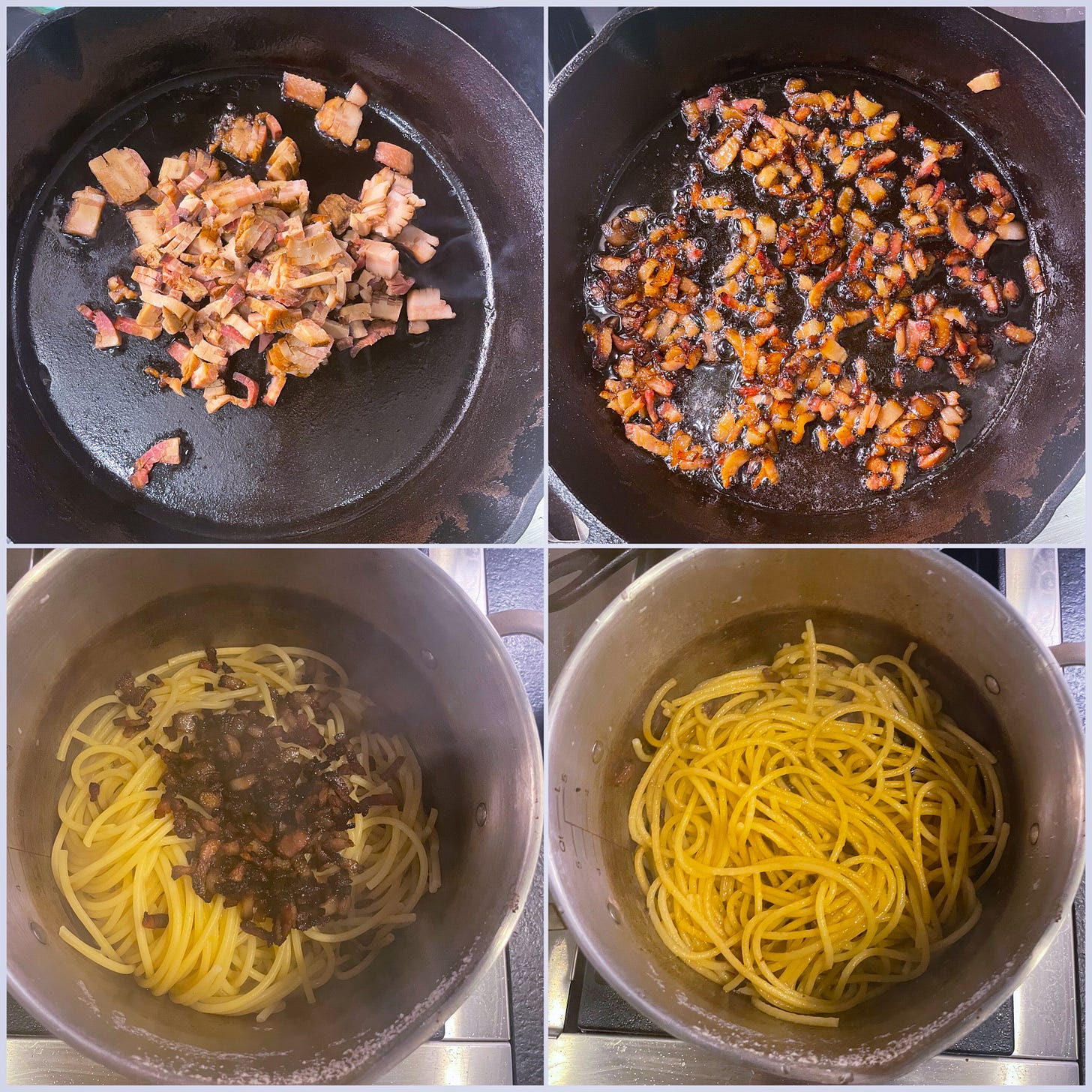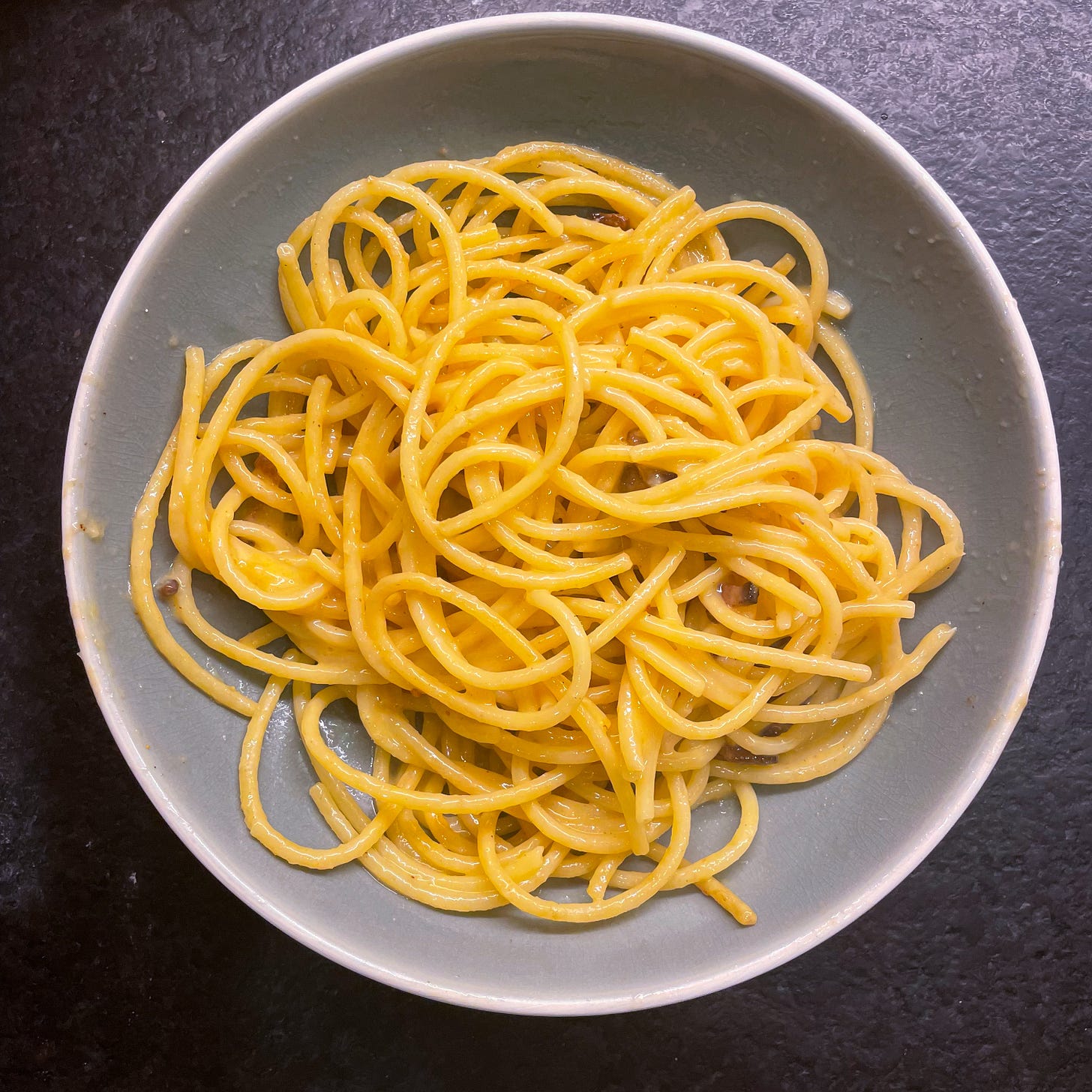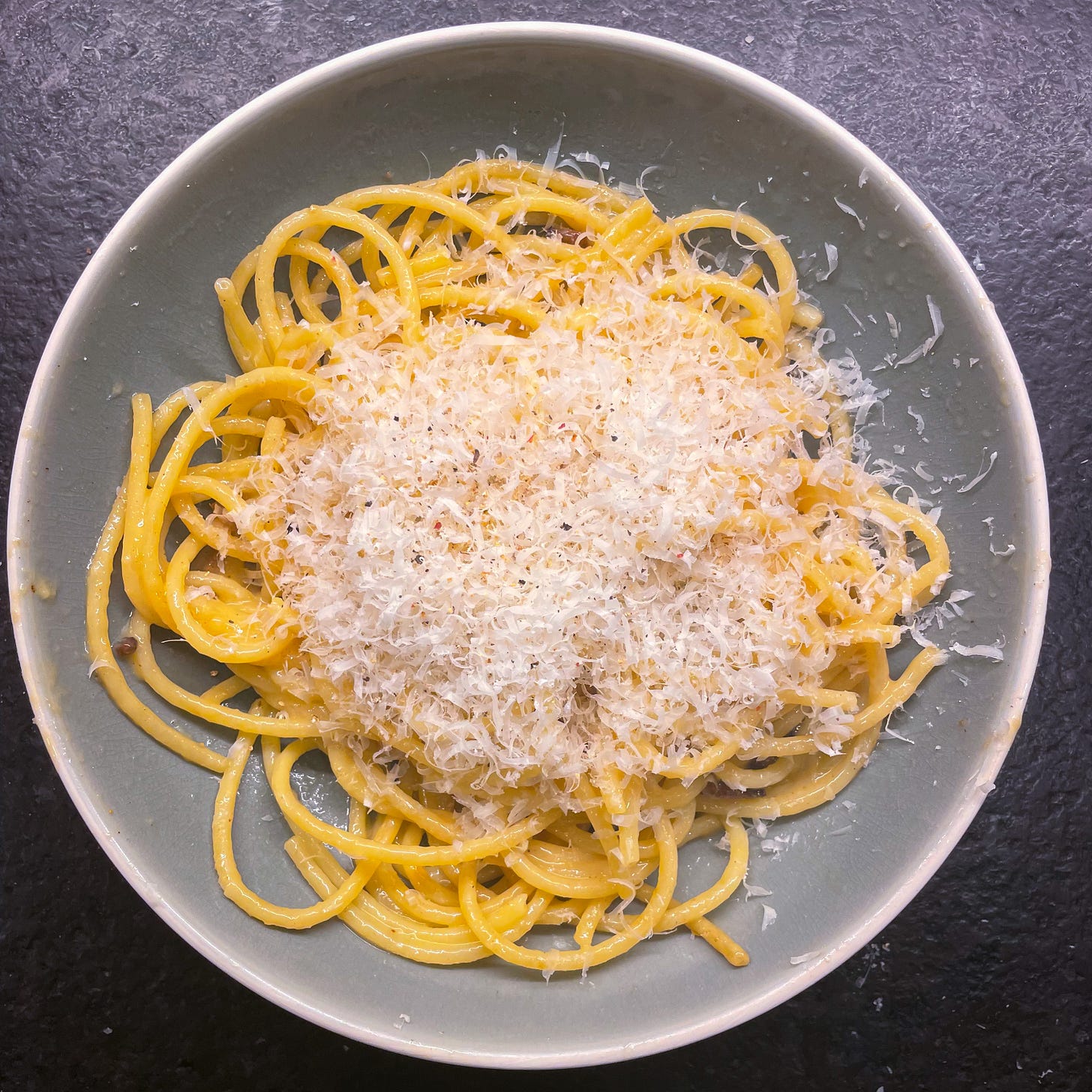After college, I moved to Providence, RI, and taught 7th grade Enlightenment Language Arts for two years. Living away from Mrs. CWD, from dining halls, for almost anything for the first time, I really, truly started experimenting with cooking1.
My diet for those two years consisted of a lot of consistency: most weeks, the meal plan was some combination of fried rice with shrimp, pasta bolognese, teriyaki salmon or tuna, chili, or some vaguely Asian-inspired amalgamation of chicken and vegetables2. The final piece of the puzzle, something that showed up weekly, like clockwork, was pasta carbonara.
I love carbonara. I love the simplicity of it, the five ingredients, the fact it comes together quickly and essentially all at once. I love that it was originally a peasant food, made in the morning and assembled by Roman workers in the field3, and that I felt a kinship with those Roman workers every time I assembled my lunch in the teacher break room. Most of all, I love justifying eating a pound of pasta, a pound of cheese, a pound of bacon, and raw eggs and calling it a meal.
Simplicity is underrated. It’s so easy to overcomplicate things, to write a novel when an essay will do4. We conflate complexity with superiority; simplicity with banality. I find myself falling into this trap sometimes in the kitchen — adding more flavors, more ingredients, trying to bring the dish together with just a little bit more. Often times, the answer is just to do less. Salt and pepper, eggs and cheese, bacon and pasta. There’s no need to make things any harder than they need to be.
A decade later, Mrs. CWD and I still make carbonara fairly often, though definitely not once a week. Give it a shot next time you want to feel like a simple Plebeian5 in the best way possible.
Fill a large pot with water, salt it well, and put it on high heat to bring to a boil. While you’re waiting for the water to boil, you can dice up at least a half pound, and probably more, of bacon6. You can also start to heat up a large pan, in which you’ll cook the bacon.
When the water hits a boil, dump in a pound of pasta and then toss your bacon into the pan7. If you time this right, your bacon should just be getting crispy right when your pasta hits al dente. Cut the heat on both, drain the pasta (reserving some of the water if you remember), put it back in your pot, and then dump the bacon and rendered fat in with the pasta. Mix well to combine.
Crack two or three eggs8 into a small bowl, grate a flurry of parm cheese9 on top, crack some black pepper, and then whisk well to combine. Plate the pasta and bacon mixture, and, while its still steaming hot, pour some of the egg and cheese mix on top, stirring vigorously with your fork10.
Grate some more cheese and crack some more pepper on top, and enjoy hot.
So there you go, pasta carbonara. I’d encourage you to make this one with really good ingredients, since it’s so simple. Great bacon, great cheese, the freshest eggs you can find — and if you’re really feeling up for it, with homemade pasta11. Like anything with so few ingredients, the final product quality goes up exponentially with better raw12 materials — and likewise, can go south pretty quickly if you skimp on them.
I don’t have much else for you. We’ve had some heady posts the last few weeks; like the carbonara, we’ll keep it simple today. Drink some water, take a shot of apple cider vinegar, and, if you’re feeling up to it, rev your heart rate up a little bit by doing something really hard outside. I’m heading to New Orleans for Roommate CWD, M.D.’s bachelor party this weekend13 , so I won't likely be doing any of those things. Gonna be a tough Monday.
Also, thanks to my roommate, co-teacher, and fast friend, this is when I picked up the nickname “Cheffy.” Of course, only the other Cheffy really calls me this — and inexplicably, so did many of our students.
Creativity was not a high priority here — Cheffy and I were just cooking just to eat.
Though practically how this worked, I’m not entirely sure.
A perfect example of this is in business writing. Utilize instead of use is a perfect example, but that’s only the tip of the iceberg. I read sentences every day that, even after reading five or six times, have no idea what the author is trying to say.
After writing this, I did a little research and found that carbonara came about relatively recently — definitely not in the ancient Roman times.
Traditionally, carbonara was made with guanciale, or maybe pancetta, but I think bacon tastes and renders better — plus I like the smoky flavor. That being said, I’ve used just about every cured pork product under the sun and never been unhappy.
The hardest part of this dish is probably the timing. You want both the bacon and the pasta to remain hot so the sauce will come together when you mix it — but if you are unsure, it’s better to have the bacon finish first and just cut the heat while the pasta cooks.
You’ll see three eggs into the photo, one a duck egg, two regular. This isn’t super scientific.
Traditionally, the recipe would call for pecorino, but we’re already bastardizing and Americanizing this with the bacon, so who cares. Do whatever floats your boat.
You want the sauce to emulsify around the hot pasta, but you don’t want to let it sit long enough to cook the egg through. This sounds harder than it actually is.
Pun! (Since the eggs are technically raw)
Roommate CWD, M.P.P, will be joining as well.













Sounds delicious-- what could be bad about anything with pasta? I guess it could be bad if you still have trouble figuring out the right way to cook the pasta, which seems like such an easy thing, but can be a problem. I seem to have a hard time with that, but Grammy CWD is the best!
Congrats to Roommate CWD MD whom I adore! Cheffy, too!
I love you, and you must know that anything with bacon dumped in it is always good.